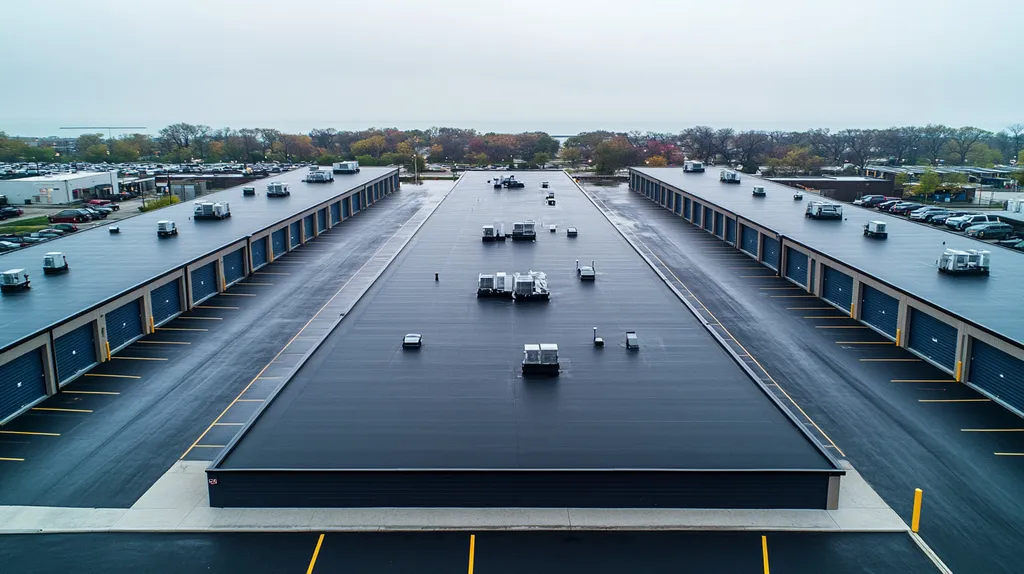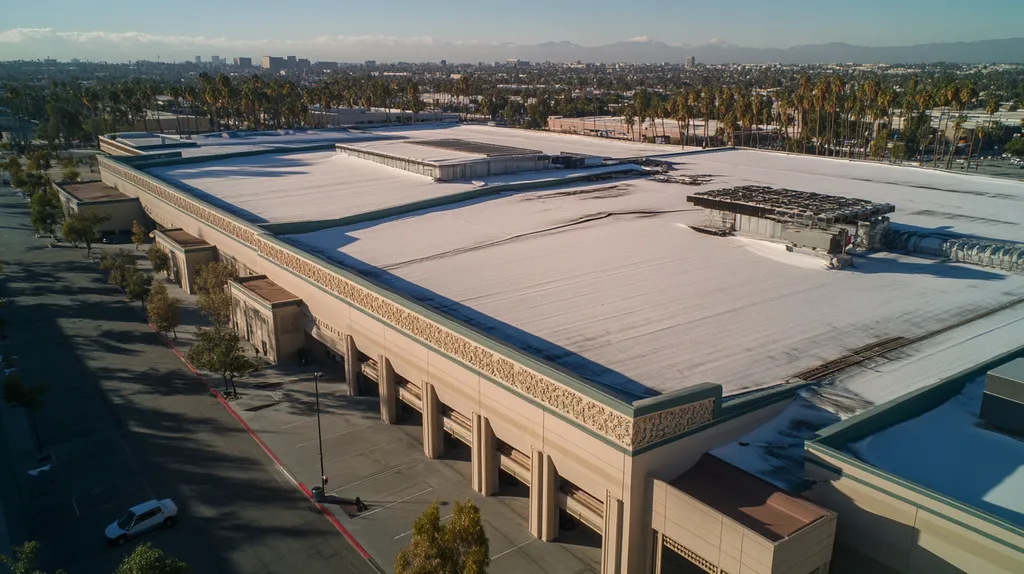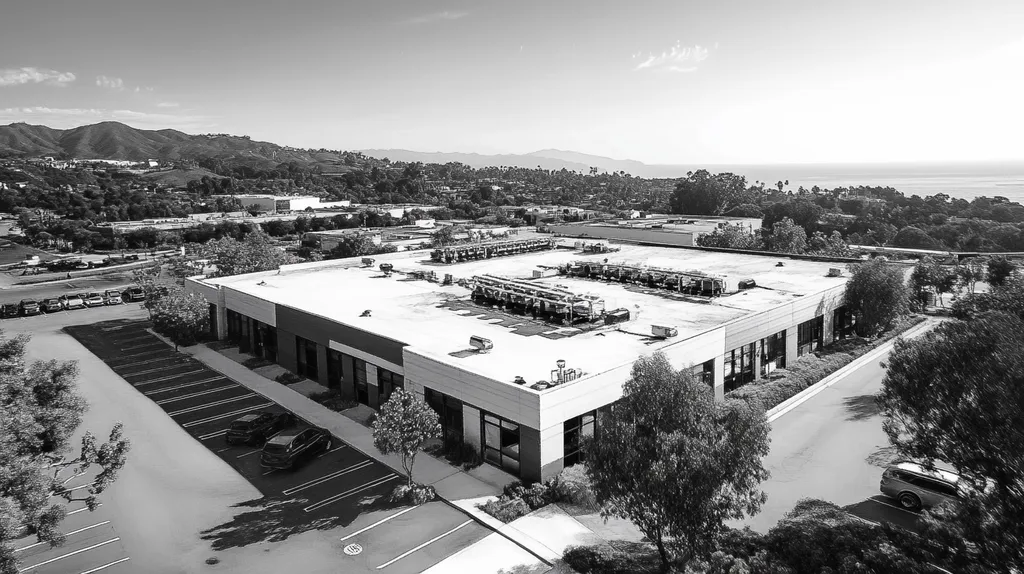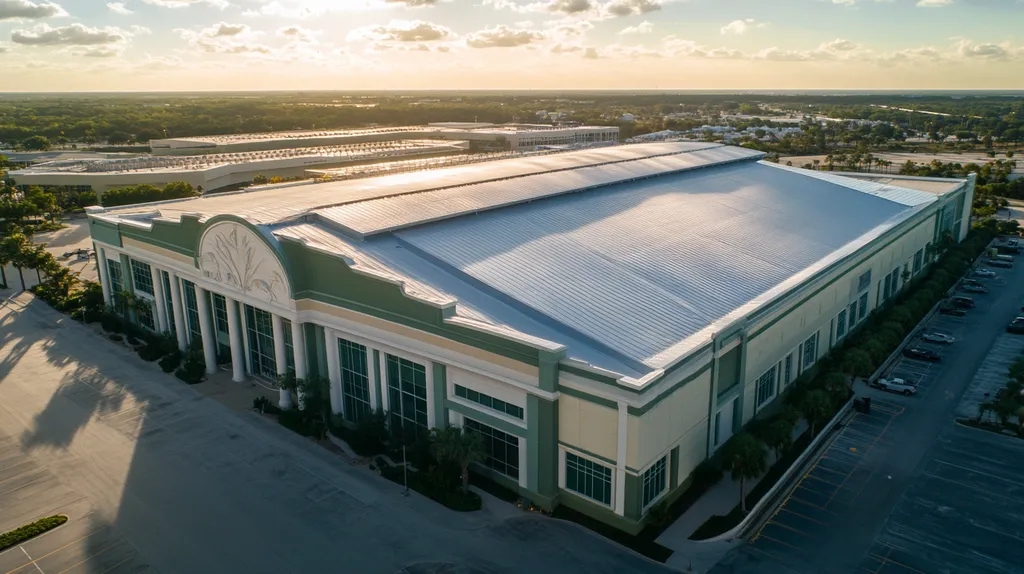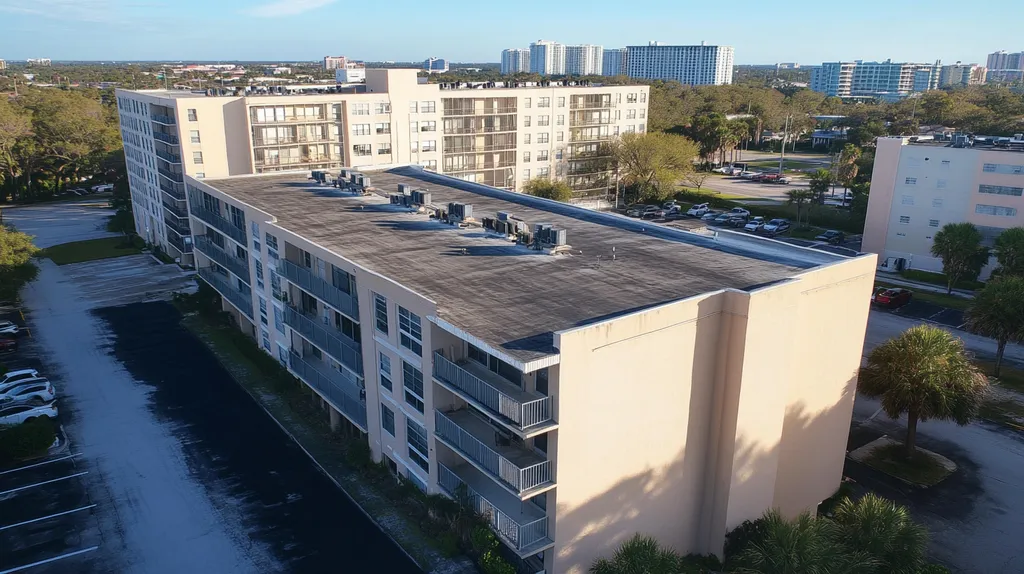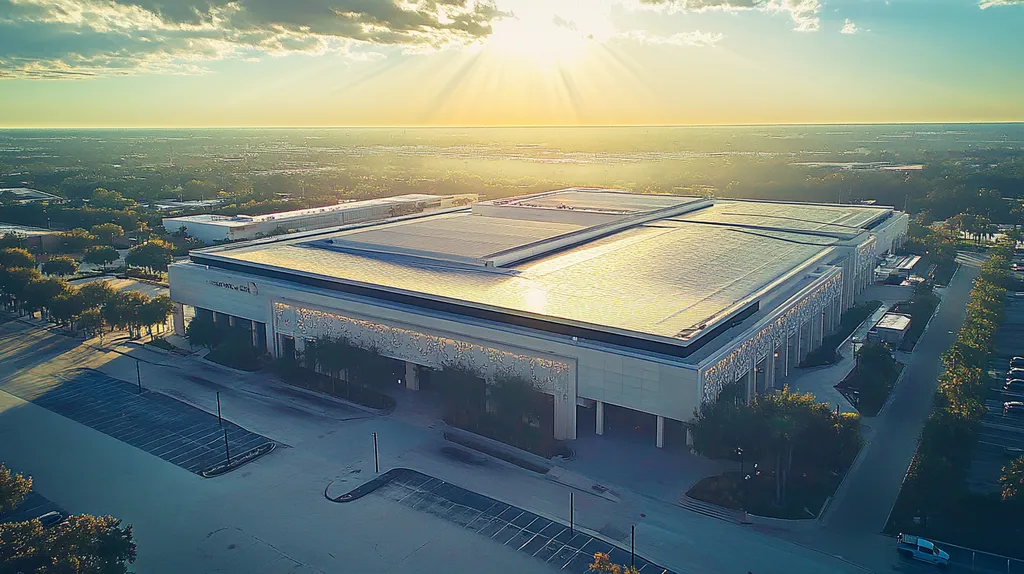During harsh winters, poor drainage on commercial roofs leads to over $500 million in annual repair costs across North America. Studies show that 40% of winter roof collapses stem directly from inadequate drainage systems and ice accumulation.
For facility managers, implementing effective cold weather drainage solutions isn’t just about preventing damage—it’s about protecting significant investments and ensuring business continuity.
This comprehensive guide examines critical factors in commercial roof drainage, from performance considerations and financial implications to compliance requirements and risk management strategies, providing actionable solutions for winter preparedness.
SECTION 1: PERFORMANCE FACTORS
As winter approaches, ensuring effective drainage on commercial roofs becomes critically important. Failing to address drainage can lead to ice accumulation, posing serious risks to roof integrity and incurring hefty repair costs. Data indicates that over half of roof failures in winter can be traced back to insufficient drainage solutions. For facility managers, grasping the essential performance factors for winter drainage—such as ice buildup, water flow, and heat trace cable placement—is vital to safeguarding their properties.
Ice Buildup and Drain Blockage
Ice accumulation can significantly threaten the durability of commercial roofs. When drainage systems become obstructed, melting snow and ice have nowhere to go, resulting in water pooling on the surface. This excess water can freeze overnight, forming thick layers of ice that complicate drainage even further.
Blocked drains heighten the risk of roof sagging and leaks. Facilities that lack regular inspections face a greater likelihood of developing foundational cracks and structural issues because of ice build-up. If left unaddressed, the costs associated with ice damage can escalate into thousands of dollars.
To reduce these risks, routine clearing of debris from gutters and drains is essential. A proactive maintenance plan can keep drainage systems clear throughout the icy months. Additionally, facility managers should assess roof slope as inadequate pitch may worsen drainage problems; ensuring appropriate site grading can greatly limit ice formation.
Key Action Items
Water Flow and Drainage Paths
Understanding how water flows during cold weather is crucial for preventing drainage complications. Many commercial roofs feature interior drains that rely on gravity, but if these drains aren’t correctly situated, water can stagnate or accumulate in low areas.
Assessing the roof’s slope is vital for promoting proper water flow, with a minimum slope of 1/4 inch per foot typically recommended to facilitate efficient drainage. Regular inspections after snow events can help identify any pooling and inform necessary adjustments to drainage paths.
Employing drainage mats or tapered insulation may also enhance water flow by guiding it toward designated drainage points, thereby improving the roof’s performance in winter weather.
Key Action Items
Heat Trace Cable Placement
Heat trace cables are effective tools for preventing ice buildup on roofs. By providing a steady source of heat, these cables keep drainage systems clear and maintain proper water flow even in freezing conditions.
Effective placement of heat trace cables is vital. They should ideally be installed in gutter systems, around drains, and along the roof edges where ice is most likely to form. Careful planning maximizes their coverage while minimizing energy costs.
Regularly checking the heat trace system is crucial; damaged or malfunctioning cables can fail to provide sufficient heating, allowing ice to accumulate. Combining these systems with insulation offers further protection against winter challenges, ensuring better overall roof longevity.
Key Action Items
SECTION 2: FINANCIAL CONSIDERATIONS
The financial ramifications of inadequate drainage during the cold months are severe. Ice buildup and stagnant water can cause extensive structural damage, leading to costly repairs and potential liability concerns. Studies indicate that poor drainage can inflate maintenance costs by as much as 40%. As stewards of their properties, facility managers must carefully analyze initial costs against the long-term financial sustainability of their buildings.
Cost of Heat Trace Cables
Heat trace cables serve as a vital first line of defense against cold weather drainage challenges. While these systems come with an upfront cost of approximately $5 to $20 per linear foot, they effectively prevent the formation of ice dams. For larger properties, this installation can add up to thousands, but consider this: avoiding one major roof failure can save tens of thousands in repair and operational loss costs.
Additionally, many manufacturers support their products with warranties, which can provide future maintenance cost relief. With reliable installation and regular inspections, heat trace cables can ensure continued protection and clear drainage for years, effectively dissolving ice and preventing blockages in pivotal areas like roof valleys and around drains (source: Valin Corporation).
In summary, the initial investment in heat trace cables is a crucial financial decision that not only safeguards the roof’s integrity but also shields facility managers from larger, unforeseen costs.
Maintenance and Repair Expenses
For facility managers, winter maintenance costs are a primary concern that can dramatically escalate if proper drainage practices are overlooked. Ice dams resulting from stagnant water can inflict severe damage on roofing materials, often necessitating pricey repairs. Many facilities report winter maintenance expenses soaring due to neglect, with repair bills sometimes exceeding $100,000 when crises arise.
Establishing regular inspections and a proactive maintenance routine can help identify drainage issues early, mitigating the risk of costly repairs. Additionally, ice-related injury claims can further drive up financial outputs, underscoring the far-reaching implications of negligence. It is essential to take proactive measures to keep expenses manageable during frigid months.
Investing in scheduled maintenance not only helps to alleviate emerging issues but also fosters a safer, more compliant working environment, ultimately leading to long-term savings.
Long-Term Cost Savings
Investing in efficient drainage solutions contributes to substantial long-term savings for property owners. A well-maintained roof that effectively mitigates ice accumulation will prolong its lifespan, decreasing the frequency and expense of future replacements. This practice ensures the roof withstands harsh winters, offering maximum durability.
Energy costs can also see a reduction; well-drained roofs help stabilize indoor temperatures, minimizing heating demands during the cold months. This leads to lower utility bills while lengthening the lifespan of roofing materials.
Moreover, properties with well-maintained roofing systems often command higher market values. Prospective buyers recognize the importance of a solid maintenance history and the effectiveness of drainage systems when considering a property. By prioritizing drainage, facility managers are likely to realize greater returns on their investments when selling or leasing their spaces.
In conclusion, while the upfront investment in effective drainage systems may seem significant, the long-term savings and benefits to property value are noteworthy. Prioritizing proper drainage safeguards the roof while enhancing the overall financial health of the facility.
SECTION 3: COMPLIANCE REQUIREMENTS
Understanding compliance requirements is crucial for managing cold weather drainage effectively on commercial roofs. Local building codes, industry standards, and insurance regulations dictate how facility managers should approach drainage solutions. Neglecting these guidelines can result in costly fines, significant property damage, and potential legal headaches. This section highlights essential compliance areas that help facility managers safeguard their assets and navigate regulatory landscapes.
Local Building Codes and Regulations
Local building codes outline specific requirements for roofing drainage systems, aiming to ensure the safety and structural integrity of buildings, particularly in colder climates prone to snow and ice. For instance, codes may stipulate a minimum slope for flat roofs to facilitate adequate drainage, preventing water accumulation that can lead to ice formation.
Non-compliance can result in serious consequences, such as fines, mandatory renovations, or even disruptions to business operations until compliance is achieved. Engaging with local building authorities during planning helps ensure that projects meet all current requirements right from the outset.
Awareness of local regulations is essential, as these codes evolve over time to address changing climate conditions and advancements in roofing technologies. Regular updates and consultations with experienced roofing professionals can help facility managers adjust their systems accordingly.
Key Action Items
Industry Standards for Roof Drainage
In addition to local codes, industry standards provide clear benchmarks for developing effective roof drainage systems in commercial buildings. Organizations like the American Society for Testing and Materials (ASTM) issue guidelines that outline best practices for drainage design and installation. Following these standards not only enhances safety but also extends the life of roofing systems.
Industry standards often include engineering assessments that identify crucial drainage points to maximize efficiency. Recommendations may specify particular types of drains to use in regions with heavy snowfall and melting conditions, ensuring that water moves away from the building’s foundation.
By adhering to industry standards, facility managers can also streamline maintenance practices, making inspections and repairs more efficient, which helps reduce downtime and mitigate weather-related issues. Training staff regularly on these standards keeps the team informed and responsive to drainage challenges.
Key Action Items
Insurance and Liability Compliance
Insurance policies frequently mandate compliance with specific drainage standards to maintain coverage. Facility managers must ensure their roof drainage systems are compliant not only to meet local codes but also to satisfy insurance requirements. Non-compliance can lead to denied claims for water damage or structural failures when problems arise.
Understanding liability implications is equally important. If an incident occurs due to improper drainage, such as water intrusion leading to mold, facility managers could face lawsuits. Insurance companies may scrutinize adherence to local codes and industry standards during claims investigations.
Facility managers should regularly review their insurance policies to stay updated on coverage related to cold weather drainage issues. Collaborating with insurance agents can provide insights into best practices that not only ensure compliance but may also result in lower premium costs.
Key Action Items
SECTION 4: RISK MANAGEMENT
As winter approaches, effective management of cold weather drainage on commercial roofs becomes paramount. Alarmingly, 40% of roof collapses happen due to accumulated snow and ice, making proper drainage critical. Facility managers play a vital role in mitigating risks related to structural damage, water intrusion, and safety hazards, ensuring the protection of both property and occupants.
Structural Damage and Collapse Risk
The weight of snow and ice exerts tremendous pressure on commercial roofs. When drainage systems falter, this weight can escalate, resulting in structural failure or even total collapse. Flat roofs that are typically equipped to handle snow can still be overwhelmed by unexpected storms.
Routine inspections of drainage systems are essential for identifying debris and ensuring functionality. Skipping these checks can put undue stress on roofing materials, advancing conditions that may compromise safety. Awareness of the load-bearing capabilities of roofing materials is vital to preventing disasters.
Investing in snow removal equipment or utilizing contracted services during winter storms is another effective strategy. Prompt snow removal helps maintain roof integrity, significantly reducing the risk of collapse. Proactive planning, including established contingency measures for severe weather events, is critical to managing these risks safely.
Key Action Items
Water Damage and Leaks Prevention
Standing water on roofs poses severe risks, not only heightening chances of collapse but also increasing the likelihood of water damage. Frozen water can create ice dams, causing leaks that threaten interiors and damage valuable assets like inventory and machinery.
To prevent these issues, facility managers should ensure all drainage pathways—such as scuppers and downspouts—are free of obstructions. Regular inspections to uncover potential blockages caused by ice or debris allow for swift action to eliminate threats.
Incorporating heated cables can effectively combat ice buildup, maintaining drainage efficiency and lowering leak risks. These proactive investments significantly enhance the long-term integrity of both the roof and the building’s interior.
Key Action Items
Safety Hazards from Ice Accumulation
Ice buildup not only threatens roof integrity but also creates hazardous conditions for those near the building. Icicles and slippery surfaces present serious safety risks for employees, customers, and pedestrians alike.
Proactively assessing areas susceptible to ice formation is essential for effective risk management. Implementing safety measures like anti-slip coatings, guardrails, and clear signage can greatly reduce the chances of accidents.
Furthermore, robust snow and ice management plans should include regular clearing of walkways and entrances. Maintaining these safety protocols as part of routine maintenance fosters a secure environment while upholding the facility’s professional appearance.
Key Action Items
SECTION 5: OPERATIONAL PROCEDURES
As winter looms, the pressure on commercial roofs intensifies. Inadequate drainage can lead to catastrophic ice dams, structural damage, or even complete roof failure. Research indicates that poorly managed water runoff can inflate repair costs by up to 30%. Therefore, facility managers must adopt stringent operational procedures now to optimize drainage systems for the cold months ahead.
Pre-Winter Inspection and Maintenance
A meticulous pre-winter inspection is essential for ensuring effective drainage on commercial roofs. Facility managers should check roofing materials and pinpoint areas vulnerable to leaks or water pooling, scrutinizing seams, flashings, and other potential weak spots.
During inspections, it is crucial to assess the slope and condition of the roof to promote adequate water flow. Any low spots that could cause water accumulation must be addressed promptly. By taking these proactive measures, facility managers can significantly mitigate risks and enhance the lifespan of their roofing systems.
Documenting findings and repair actions during inspections is equally vital. This record can serve as an invaluable resource for future maintenance decisions, tracking performance issues over time. Waiting until snowfall to confront maintenance problems can lead to substantial setbacks.
Key Action Items
Cleaning and Clearing Drainage Systems
Regular cleaning and clearing of drainage systems are critical to avert blockages from snow and ice. Facility managers should establish a maintenance schedule dedicated to gutters, downspouts, and drains, ensuring unobstructed water flow.
Debris, leaves, and standing water can foster conditions conducive to ice buildup and obstruct drainage pathways. A thorough clean-up before winter is necessary to eliminate these hazards. Utilizing tools such as pressure washers or industrial vacuums can enhance the efficiency of this critical task.
Additionally, evaluating the current drainage system’s effectiveness is crucial. If inefficiencies are identified, such as poorly designed slopes or inadequate outlets, upgrades should be considered to bolster performance during snowmelt events. Implementing eco-friendly de-icers can also help manage freeze-ups effectively.
Key Action Items
Monitoring and Testing Heat Trace Cables
Heat trace cables are invaluable for maintaining clear drainage channels during winter conditions. They actively prevent ice formation on roof surfaces and throughout drainage systems. Regular testing and monitoring should be integral to any facility’s operational procedures.
Facility managers should routinely inspect connections and power supplies for heat trace systems. Any damaged cables must be repaired or replaced proactively, well ahead of severe winter conditions, to ensure consistent functionality.
Implementing a monitoring system to automatically alert managers to temperature drops can significantly enhance situational awareness. Being informed promptly allows teams to take immediate steps to avert ice blockages, safeguarding the facility’s drainage capabilities.
Key Action Items
SECTION 5: OPERATIONAL PROCEDURES
As winter approaches, the stakes for maintaining commercial roofs rise dramatically. Inadequate drainage not only risks damaging ice dams but can lead to structural failure and costly repairs. Research indicates that poorly managed water runoff can increase repair costs by nearly 30%. Therefore, facility managers must implement stringent operational procedures now to ensure that drainage systems operate effectively throughout the cold months ahead.
Pre-Winter Inspection and Maintenance
Conducting a thorough pre-winter inspection is vital for ensuring effective drainage on commercial roofs. Facility managers must assess roofing materials and identify vulnerable areas prone to leaks or water pooling, paying close attention to seams, flashings, and other potential weak points.
During these inspections, it is essential to evaluate the slope and overall condition of the roof to facilitate adequate water flow. Any low spots that could lead to water accumulation should be corrected immediately. These proactive measures will help mitigate risks and extend the lifespan of roofing systems.
Additionally, documenting findings and actions taken during the inspection is crucial. This record serves as a valuable reference for future maintenance and can help track performance issues over time, avoiding the pitfalls of waiting until snowfall to address maintenance concerns.
Key Action Items
Cleaning and Clearing Drainage Systems
Regular cleaning and clearing of drainage systems are essential to prevent blockages caused by snow and ice accumulation. Facility managers should establish a dedicated maintenance schedule for gutters, downspouts, and drains to ensure unimpeded water flow.
Leaves and debris, if left unchecked, can create conditions leading to ice buildup and hinder drainage pathways. A thorough cleaning before winter is crucial to eliminate these hazards, and using pressure washers or industrial vacuums can enhance the effectiveness of this task.
Moreover, managers should evaluate the existing drainage systems for effectiveness. If inefficiencies are detected—such as poorly designed slopes or inadequate outlets—upgrades should be considered to enhance performance during snowmelt events. Implementing eco-friendly de-icers can also help manage freeze-ups and streamline the drainage process.
Key Action Items
Monitoring and Testing Heat Trace Cables
Heat trace cables play a crucial role in maintaining clear drainage channels during winter. These cables mitigate ice formation on roofs and throughout drainage systems, making regular testing and monitoring essential for any facility’s operational procedures.
Facility managers need to inspect the connections and power supplies of heat trace systems regularly. Any damaged cables must be replaced promptly to ensure reliable functionality well before the winter weather arrives.
Implementing a monitoring system that alerts managers to temperature drops can greatly enhance situational awareness. Timely notifications enable teams to take swift action to prevent ice blockages, thus securing the facility’s drainage capabilities. Evaluating the placement of heat trace cables ensures they are situated in critical areas for optimal effectiveness.
Key Action Items
Moving Forward
With winter-related roof damage costing North American businesses over $500 million annually, the imperative for proper cold weather drainage has never been clearer.
Effective drainage solutions represent more than just preventive maintenance—they are critical investments in business continuity and asset protection.
From regulatory compliance and risk mitigation to operational efficiency and long-term cost savings, comprehensive drainage strategies demand year-round attention.
The integration of modern technologies like heat trace systems, coupled with rigorous inspection protocols and clear maintenance procedures, provides facility managers with powerful tools to combat winter challenges.
By implementing these proven solutions and maintaining vigilant oversight, facility managers can significantly reduce their vulnerability to cold weather drainage issues while protecting their substantial roofing investments.
FREQUENTLY ASKED QUESTIONS
Q. What performance factors affect drainage on commercial roofs?
A. Performance factors include ice buildup, water flow, and heat trace cable placement. Understanding these elements helps facility managers maintain effective drainage and protect the structural integrity of roofs during winter. Regular inspections and addressing issues proactively can mitigate costly damages.
Q. How can insufficient drainage affect commercial roof costs?
A. Insufficient drainage can lead to extensive structural damage and inflated maintenance costs. When repairs are required due to ice buildup or leaks, facility management expenses can skyrocket, emphasizing the need for preventive measures. Investing in proper drainage solutions reduces long-term expenditures.
Q. What compliance requirements should facility managers consider for drainage?
A. Facility managers must be aware of local building codes, industry standards, and insurance regulations. Compliance with these guidelines is essential to prevent costly fines and damages, ensuring proper drainage solutions are implemented to meet necessary safety standards.
Q. How can structural damage risks be managed on commercial roofs?
A. Managing structural damage risks involves routine inspections and timely snow removal from roofs. Recognizing the load-bearing capabilities and maintaining drainage systems can mitigate collapses. A proactive plan ensures the roof’s integrity and protects both property and occupants.
Q. What operational procedures are necessary for winter roof drainage?
A. Conducting pre-winter inspections and maintaining drainage systems are crucial operational procedures. Regular cleaning, monitoring heat trace cables, and documenting maintenance actions ensure systems work effectively throughout winter, leading to enhanced drainage and prolonged roof lifespan.
Q. How can facility managers prevent water damage on commercial roofs?
A. Preventing water damage requires keeping drainage pathways clear and utilizing heating solutions like heat trace cables. Regular inspections for blockages and timely maintenance significantly lower the risk of leaks, safeguarding both the roof and interior assets.
Q. What additional safety measures can be implemented during the winter?
A. Facility managers can implement anti-slip coatings, install guardrails, and ensure visible signage in areas prone to ice buildup. Regularly clearing walkways and entrances enhances safety for those near the building while promoting a secure environment.

